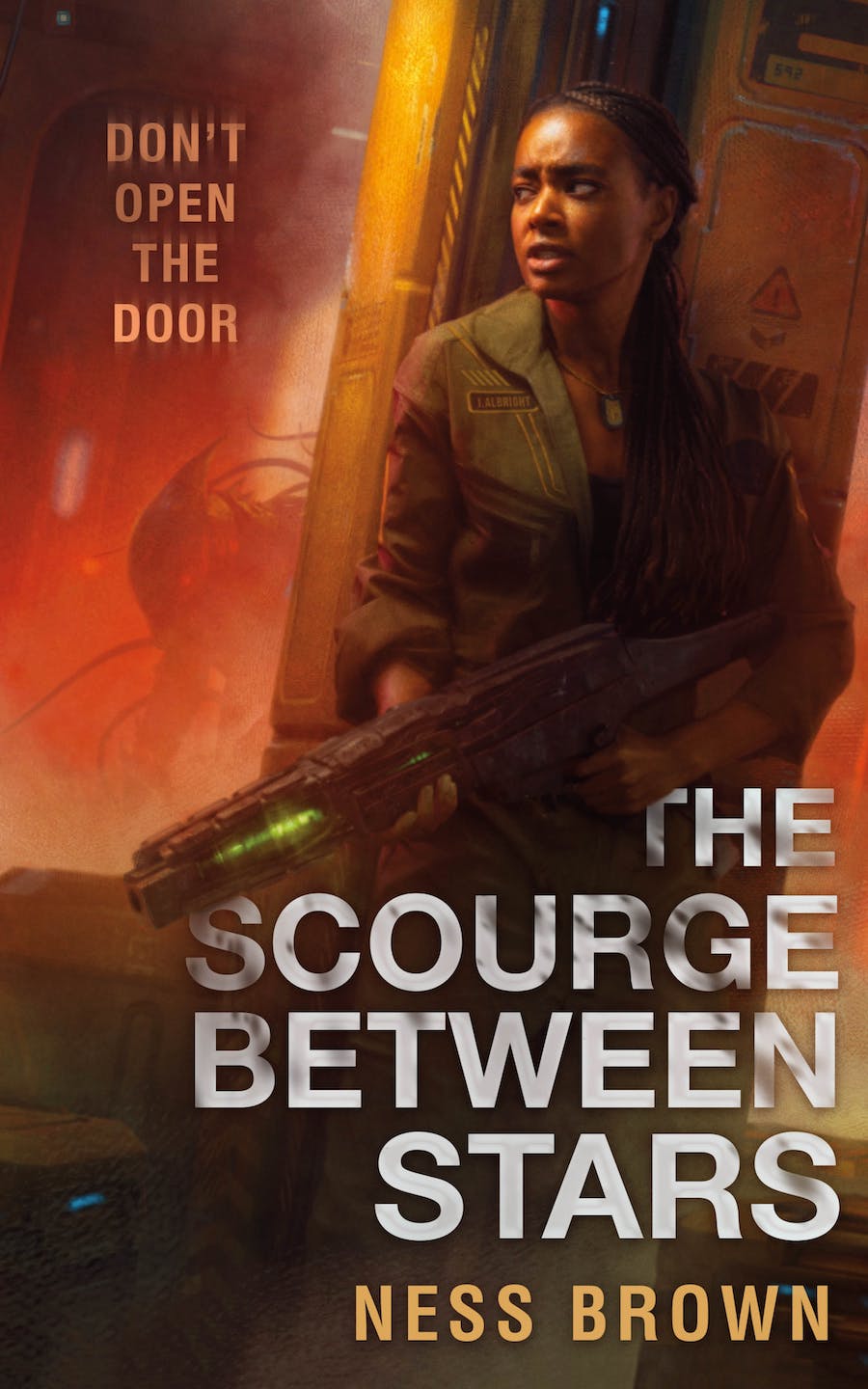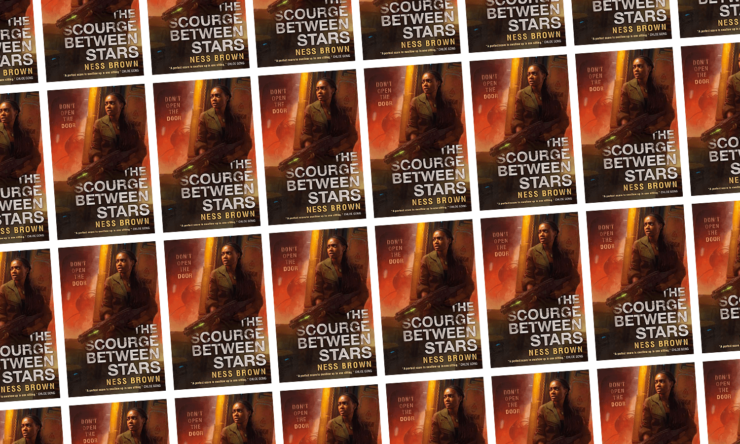Generation ships never seem to work out well. Food and energy and water run to dangerously short supply with no way to restock; or the morale of a people who’ve never seen anything but the steel bolts of a spaceship’s interior turns to despair or mutinous anger; or the shipboard robots start making their own, coldly calculated decisions without a care for their passengers. The Calypso of Ness Brown’s The Scourge Between Stars seems to be going through every one of these crises and more—and that’s before a vicious, insectile creature crawls from the bulkheads to start killing people.
First mate and acting captain Jacklyn Albright helms a generation ship limping its way home to Earth after the promise of an extraterrestrial colony failed to pan out. It’s rough going. Chunks of the Calypso are torn off by the crossfire of unknown assailants lurking in space, which the ship can neither see nor hear: “the gods duking it out,” as these engagements are memorably described. And this constant invisible siege is only the start of cascading problems, including fatally low food supplies, rioting among the ship’s population, a rogue android that fries the bridge’s computer systems.
Running from one problem to another, without being able to permanently fix any of them, prevents Jacklyn from getting any sleep. (It also prevents her from spending time with her girlfriend, third mate Jolie Singh.) But more importantly for the structure of the book, it keeps her from catching on to the alien intruder too quickly.
Buy the Book


The Scourge Between Stars
Space has always been an effective setting for these kinds of “Monster in the House” stories—because on a spaceship, there’s nowhere to go. Space is a deeply hostile environment that, unprotected, will kill you in seconds; and besides that, there’s no rescue or help or hope of salvation for tens of trillions of miles. Characters have to confront the threat directly. The question Brown is forced to navigate, and does so skillfully, is how to tease out this dramatic irony without making Jacklyn feel like the stereotypical horror protagonist, willfully oblivious to the true threat she faces. Jacklyn and her crew are competent and trust one another—with the exception of the creepy head technician Otto Watson—and once people start dying, they figure out almost immediately that there’s a murderous alien loose on the ship, and how to corral and contain it. But the tension has already been ratcheted up by the garbled transmission from another ship in the fleet, pleading with anyone listening not to open the door, and mysterious banging sounds from within the ship’s walls. These weigh on Jacklyn, infiltrating her nightmares and leaving her with burning questions. She’d figure it out, we’re shown, if only the ship wasn’t falling apart around her every waking moment.
And yet the story manages never to feel hopeless. Even if the Calypso might never make it back to Earth, even if the rest of their motley and ramshackle fleet have gone radio silent from this unknown alien intrusion—there’s a sense among Jacklyn and her crew that they still must do what they can. And for Jacklyn, it’s personal. Remember that whole ‘acting captain’ title? Her father, the actual captain, has locked himself in his cabin for the past two weeks and isn’t answering his communications. Interior sensors tell her he’s not dead, but in abdicating his duties, having “disappeared and damned them all,” he’s burdened Jacklyn with the responsibility of everyone’s lives and safety.
So because Jacklyn cares about her crew, we as readers care too. They’re her family where her father refuses to be. There’s the short but fierce security chief, Michiko Tomimori, who Jacklyn grew up learning every detail of the Calypso’s interior from, and who becomes the backbone of the defense against the alien intruder; and her counterpart in Viktorija Novak, first engineer, tall and courteous and the reason that the Calypso hasn’t fallen apart yet. The bridge crew helps hold her together and make tough decisions—which on the ship are all too common.
The Calypso is made up of much more than them, though—a whole contingent of nameless ‘officers’ and ‘techies’ who make up the rest of the ship’s population, and who occasionally become redshirts for the prowling alien predators.
It’s also a book that’s not afraid to play with its medium a little. There’s one page that’s stuck with me because it was so unexpectedly cool, set when Jacklyn and her team are descending into the depths of the Calypso. The top of the page is normal—white background, black text—and on it the first half of the sentence: “The lift doors opened”. The rest of the page is completely black, and halfway down is the rest of the sentence: “to pitch darkness.”
It’s impressive. It’s cool. It’s clever. I was only disappointed because there wasn’t more of it. So much of the visual of horror is defined by shadow, by darkness, by what the characters can’t see and therefore can imagine is lurking in those inky pools. And of course Jacklyn and her team’s lights can’t illuminate more than a few feet of this darkness, and so they too are left to fear it. Brown does a great job of describing Jacklyn’s growing anxiety, creeping through these unlit corridors—but to create a visual in the book itself adds an entire other layer.
In the end, The Scourge Between Stars is a classic space horror story done right, with enough clever twists—in the page and on the page—to keep the setting fresh and the tension high. And remember: don’t open the door.
The Scourge Between Stars is published by Nightfire.
Read an excerpt here.
Charles Bonkowsky is the president of Columbia University’s Science Fiction Society and loves talking to people about books.










